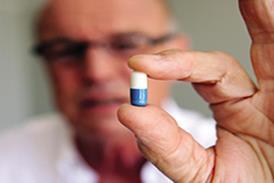To fully capture and stimulate NHS service innovation, Academic Health and Social Care Networks must go beyond striving to bring remote research into practice and include a focus on workforce innovation. Laurence Benson explains.
The government’s Innovation, Health and Wealth report is clear about the need to capture and stimulate innovation. One way it proposes to do this is by establishing more Academic Health and Social Care Networks (AHSNs).
These networks are intended to create the demand for service innovation, and encourage collaboration between health and education providers to achieve service innovation quickly.
St George’s, University of London and St George’s Healthcare Trust have led the development of such a network - the South West London Academic Health and Social Care System (AHSCS). What lessons can be learned from this experience?
The AHSCS has shown the benefit of looking beyond bench-to-bedside research, which is the focus of much innovation rhetoric, to those areas where innovation is more immediate. This is often achieved by enabling clinicians to build on existing knowledge and use it in new ways.
By bringing together academic and service colleagues around a mix of commissioned work programmes, the network has helped introduce service changes which have led to direct patient benefits. These programmes either scale up innovations to new settings or address agreed medium-term priorities by bringing together collaborators from across organisational, professional and sector boundaries.
The aim has been three fold: to promote the application of research into practice; to update initial professional education and boost post-qualification curricula to include innovation as a topic; and to use education to stimulate diffusion.
Perhaps more importantly, the AHSCS has brought research questions from practitioners to academic colleagues. This has built a growing appetite for understanding how to address the “not-invented-here” issue by seeking to build the evidence base to support service change. In part, this is designing in evaluation as part of service change. What seems to be working well in practice can be evaluated to create the evidence base to support investment in extending to new areas.
A prime example of this is the handful of trusts involved in virtual ward projects, which use predictive models to provide community care where it is needed and reduce hospital readmissions in a cost-effective way.
But even the best innovations take time to become accepted. AHSN links can aid project support across its life cycle. The AHSCS did this to help the introduction to England of the physician assistant role. In 2010 when the first cohort graduated, many were unable to find work. Using clinical links, the AHSCS demonstrated the value of these professionals. New PA posts were created and are now taking pressures off doctors.
The challenge to make these roles more widespread rapidly becomes a question for education commissioners stimulating demand with service providers.
Embedding innovation into the education curricula
Innovation is often feared by NHS managers facing unmet needs that require new services with demands for additional funding. This can change with an appreciation of programme budgeting – understanding the costs of both existing and new services, and commissioning for those things that make most difference. AHSNs can bring academics and clinicians together to overcome this, and other issues, where relatively small changes can make a positive impact on patient care.
One of the criticisms of Innovation, Health and Wealth is that it reads like an instruction – “on Thursday you will innovate”. This criticism misses the point. The report seeks to introduce a culture change to embed innovation into the education curricula for existing and future workforces, to teach practitioners how to innovate within their roles as part of how they work.
By bringing people together across organisations to discuss future needs, AHSNs can help academia devise curricula for the future workforce. For example, the new degree-level nursing programme jointly run by Kingston and St George’s universities includes a focus on research and innovation across all modules, in addition to a module dedicated to developing nursing practice through research and innovation.
In London, local studies have indicated non-clinical managers’ use of sources of new knowledge is weaker than their clinical colleagues. This includes questioning and reflecting on their own practice, as well as seeking knowledge about how to improve it. The effect is that managers’ access to new innovation tends to be mediated by their clinical colleagues or their approach to leadership innovations is spliced-in through management consultancy.
The AHSCS has shown through stimulating conversation and providing listening points it can provide the local leadership and horizontal pressures to connect bright ideas with an evidence base. This fulfils the commitment to improve services and delivers enhanced organisational performance. It has not been a question top down versus bottom up but an acceptance that solutions can be found in the spaces between teams.
























No comments yet